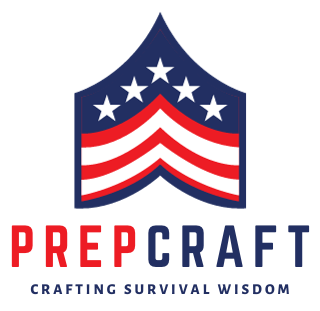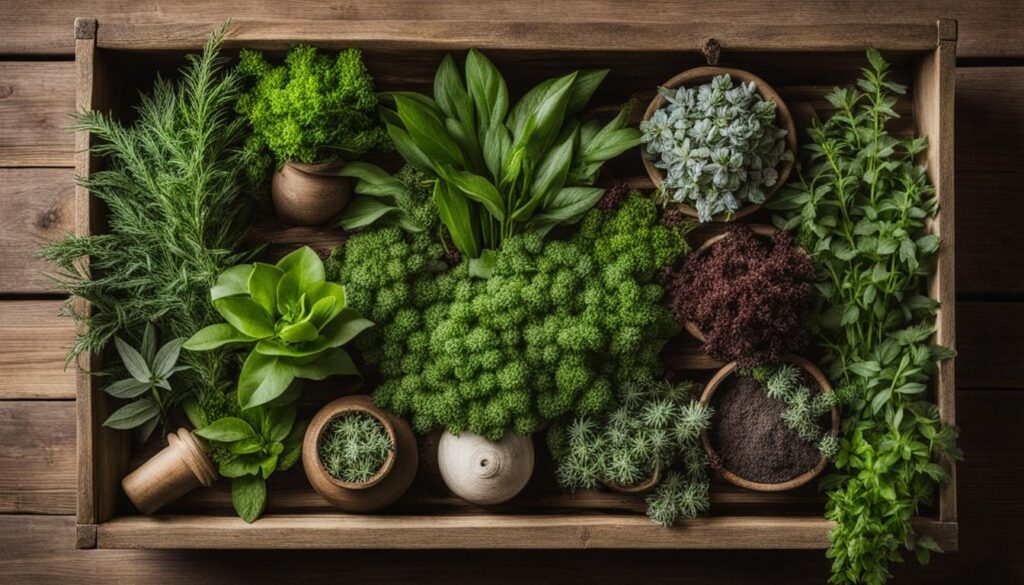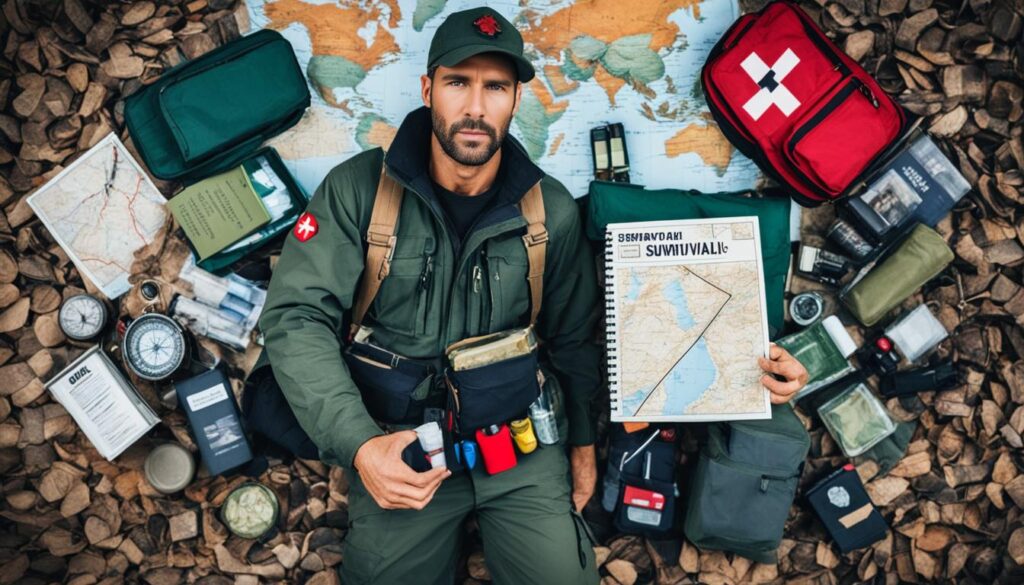
Survival training is a vital skill set for anyone seeking self-reliance in challenging and unpredictable situations. In this section, I will introduce you to the fundamental concepts of survivalist training, why it is crucial, and how you can prepare for it.
Survivalist training encompasses a wide range of skills that can mean the difference between life and death in emergency situations. From bushcraft to first aid, fire making to food procurement, these skills are essential for navigating wilderness environments.
Building these skills can empower individuals with the ability to find or build shelter, source safe drinking water, treat injuries, and secure food from the wild. By equipping oneself with survivalist skills, you can confidently face the challenges of surviving in the wild with resilience and resourcefulness.
Key Takeaways:
- Survivalist training covers various skills including bushcraft, first aid, shelter building, fire making, water sourcing and purification, and food procurement.
- These skills are crucial for coping and thriving in emergency situations.
- Survival training prepares individuals to respond to challenges and emergencies with a clear mind.
- Physical fitness is important in preparing for survival training.
- Becoming a certified survival instructor requires extensive training and certification courses.
Why Should I Take Survival Training?

Survival training is essential for gaining the necessary knowledge and skills to survive in wilderness environments. With the unpredictable nature of outdoor adventures, it is crucial to be prepared for any situation that may arise. Survival training equips individuals with a wide range of survival skills, including:
- First Aid: Learning basic first aid techniques can be life-saving in emergency situations. Understanding how to treat injuries and provide immediate care can significantly increase the chances of survival.
- Shelter Building: Knowing how to construct a shelter to protect yourself from the elements is crucial in survival scenarios. Survival training teaches various techniques for building effective shelters in different environments.
- Fire Making: Fire provides warmth, light, and the ability to cook food. Survival training teaches individuals how to start and maintain a fire using various methods, ensuring access to these essential resources.
- Water Sourcing and Purification: Finding and purifying water is vital for survival. Survival training educates individuals on techniques to locate and make water safe for consumption.
- Food Procurement: In a survival situation, knowing how to find and procure food from the wild can be essential. Survival training provides guidance on identifying edible plants, foraging, and hunting techniques.
- Navigation: Being able to navigate in the wilderness is crucial for finding your way to safety. Survival training teaches navigation skills using tools such as compasses and maps, as well as natural navigation techniques.
By acquiring these survival skills, individuals can confidently face challenging situations and enhance their chances of survival. Survival training empowers individuals to rely on their own abilities, fostering self-reliance and resilience in the face of adversity.
Survival training equips individuals with the necessary skills to survive and thrive in challenging wilderness environments.
Taking part in survival training not only increases your chances of survival but also provides a sense of confidence and empowerment. Knowing that you have the skills to navigate through the wilderness, provide first aid, build shelter, start a fire, find water, and procure food can significantly reduce anxiety and fear in outdoor situations.
Embrace the opportunity to learn from experienced instructors and fellow survival enthusiasts. Survival training is a transformative experience that can enhance your outdoor adventures and potentially save lives.
What Should I Do to Prepare for Survival Training?
To ensure a successful experience in survival training, it is crucial to approach it with an open mind and a readiness to embrace challenges. Survival training is designed to equip individuals with the necessary skills and knowledge to navigate through various situations and emergencies with a clear head. In addition to mental preparedness, physical fitness plays a vital role in survival training. Follow these steps to adequately prepare for your upcoming training:
Maintain an Open Mind
Survival training presents unique challenges and situations that may test your mental and emotional resilience. Approach the training with an open mind, ready to learn new skills and adapt to unfamiliar environments. Cultivating a flexible mindset will help you make informed decisions and overcome obstacles during your training.
Build Physical Fitness
Physical preparedness is essential for survival training. Engage in regular physical activities such as hiking, walking, or jogging to improve your endurance and stamina. Strength training exercises will enhance your physical capabilities and make tasks during training more manageable. Gradually increase the weight in your backpack to simulate real-life scenarios and ensure you can handle at least 50 pounds comfortably.
Equip Yourself with the Right Gear
Having the appropriate gear is crucial for survival training. Invest in high-quality outdoor essentials such as sturdy boots, weather-resistant clothing, and a reliable backpack. Additionally, pack essentials such as a compass, first aid supplies, a knife, a fire starter, and a water purification system. These items will aid you in navigating, tending to injuries, and fulfilling basic survival requirements.
Embrace Challenges and Seek Guidance
Survival training is meant to challenge you physically and mentally. Embrace these challenges as opportunities for growth and skill development. Be open to guidance from experienced instructors and fellow trainees. Their expertise and insights can enhance your learning experience and help you develop a comprehensive survival skill set.
By approaching survival training with an open mind, physical fitness, and the right equipment, you will be well-prepared to tackle the challenges and gain valuable skills that can benefit you in both emergency situations and everyday life.
How Do I Become a Certified Survival Instructor?

Becoming a certified survival instructor requires dedication and extensive training. To join the ranks of certified instructors, individuals must complete certification courses that offer comprehensive education over several months. These courses are designed to equip aspiring instructors with the knowledge and skills needed to teach and guide others in basic bushcraft and survival skills.
Investing time and effort into these certification courses is essential. The training curriculum includes a combination of theoretical knowledge and practical application, covering topics such as shelter building, fire making, navigation, first aid, and food procurement. Students will undergo rigorous training, honing their skills in various survival scenarios and learning effective teaching methods.
Benefits of Becoming a Certified Survival Instructor
- Opportunity to share knowledge and help others develop crucial survival skills
- Enhanced understanding and mastery of survival techniques
- Potential for employment with survival schools and programs
- Networking opportunities within the survival training community
Once certified, survival instructors play a pivotal role in empowering individuals to become self-reliant in outdoor and emergency situations. Armed with the necessary skills and expertise, certified instructors can make a significant impact on their students’ lives.
“Becoming a certified survival instructor is a journey that requires time and effort, but the rewards are immeasurable. Through proper training and certification, instructors can share their passion for survival skills and help others become better equipped to face challenges in the wilderness.”
Whether you aspire to teach survival skills professionally or simply want to deepen your understanding of survival techniques, embarking on the path to becoming a certified survival instructor is a rewarding endeavor. By obtaining the necessary certification, you will not only expand your knowledge but also have the opportunity to inspire and educate others on essential life-saving skills.
Kids and Survival Training
Survival training is not only beneficial for adults but also highly encouraged for children. Starting survival training at a young age not only increases a child’s chances of survival in emergencies but also has a profound impact on their character development, fostering outdoor appreciation, and creating lasting friendships with fellow participants.
Survival training for kids offers a unique blend of fun and education. It enhances their camping and outdoor adventures by equipping them with valuable life skills. Learning how to build shelter, start a fire, find clean drinking water, and forage for food instills a sense of self-reliance and confidence in children, empowering them to overcome challenges in any situation.
Furthermore, survival training helps children develop a deep appreciation for the great outdoors. They learn to respect and understand nature, recognize its resources, and become responsible stewards of the environment. Through hands-on experiences in survival training, kids gain a greater connection with nature and develop a lifelong passion for the outdoors.
In addition to the practical skills and appreciation for nature, survival training for kids creates opportunities for social growth. Working together in a team, children learn the importance of communication, cooperation, and problem-solving. They form lasting bonds with their fellow participants, as they navigate through exciting and challenging scenarios.
FAQ
What topics are covered in survival training courses?
Survival training courses cover topics such as bushcraft, basic survival skills, first aid, shelter building, fire making, water sourcing and purification, and food procurement.
Why is survival training important?
Survival training provides vital knowledge and skills for coping and thriving in emergency situations. It teaches basic survival skills such as first aid, shelter building, fire making, water sourcing and purification, and food procurement.
How should I prepare for survival training?
To prepare for survival training, it is important to have an open mind and be ready to face challenges. Physical preparation, such as hiking and building endurance and strength, is also crucial.
How do I become a certified survival instructor?
Becoming a certified survival instructor requires extensive training, including completing certification courses and acquiring the necessary knowledge and skills.
Is survival training suitable for children?
Yes, survival training is beneficial for children as it increases their chances of survival in emergencies, while also building character, fostering outdoor appreciation, and potentially creating lifelong friendships with other participants.


